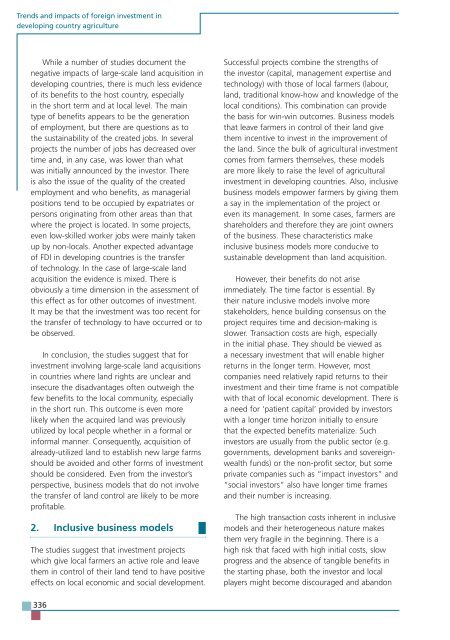TRENDS AND IMPACTS OF FOREIGN INVESTMENT IN DEVELOPING COUNTRY AGRICULTURE
TRENDS AND IMPACTS OF FOREIGN INVESTMENT IN DEVELOPING COUNTRY AGRICULTURE
TRENDS AND IMPACTS OF FOREIGN INVESTMENT IN DEVELOPING COUNTRY AGRICULTURE
Create successful ePaper yourself
Turn your PDF publications into a flip-book with our unique Google optimized e-Paper software.
Trends and impacts of foreign investment in<br />
developing country agriculture<br />
While a number of studies document the<br />
negative impacts of large-scale land acquisition in<br />
developing countries, there is much less evidence<br />
of its benefits to the host country, especially<br />
in the short term and at local level. The main<br />
type of benefits appears to be the generation<br />
of employment, but there are questions as to<br />
the sustainability of the created jobs. In several<br />
projects the number of jobs has decreased over<br />
time and, in any case, was lower than what<br />
was initially announced by the investor. There<br />
is also the issue of the quality of the created<br />
employment and who benefits, as managerial<br />
positions tend to be occupied by expatriates or<br />
persons originating from other areas than that<br />
where the project is located. In some projects,<br />
even low-skilled worker jobs were mainly taken<br />
up by non-locals. Another expected advantage<br />
of FDI in developing countries is the transfer<br />
of technology. In the case of large-scale land<br />
acquisition the evidence is mixed. There is<br />
obviously a time dimension in the assessment of<br />
this effect as for other outcomes of investment.<br />
It may be that the investment was too recent for<br />
the transfer of technology to have occurred or to<br />
be observed.<br />
In conclusion, the studies suggest that for<br />
investment involving large-scale land acquisitions<br />
in countries where land rights are unclear and<br />
insecure the disadvantages often outweigh the<br />
few benefits to the local community, especially<br />
in the short run. This outcome is even more<br />
likely when the acquired land was previously<br />
utilized by local people whether in a formal or<br />
informal manner. Consequently, acquisition of<br />
already-utilized land to establish new large farms<br />
should be avoided and other forms of investment<br />
should be considered. Even from the investor’s<br />
perspective, business models that do not involve<br />
the transfer of land control are likely to be more<br />
profitable.<br />
2. Inclusive business models <br />
The studies suggest that investment projects<br />
which give local farmers an active role and leave<br />
them in control of their land tend to have positive<br />
effects on local economic and social development.<br />
336<br />
Successful projects combine the strengths of<br />
the investor (capital, management expertise and<br />
technology) with those of local farmers (labour,<br />
land, traditional know-how and knowledge of the<br />
local conditions). This combination can provide<br />
the basis for win-win outcomes. Business models<br />
that leave farmers in control of their land give<br />
them incentive to invest in the improvement of<br />
the land. Since the bulk of agricultural investment<br />
comes from farmers themselves, these models<br />
are more likely to raise the level of agricultural<br />
investment in developing countries. Also, inclusive<br />
business models empower farmers by giving them<br />
a say in the implementation of the project or<br />
even its management. In some cases, farmers are<br />
shareholders and therefore they are joint owners<br />
of the business. These characteristics make<br />
inclusive business models more conducive to<br />
sustainable development than land acquisition.<br />
However, their benefits do not arise<br />
immediately. The time factor is essential. By<br />
their nature inclusive models involve more<br />
stakeholders, hence building consensus on the<br />
project requires time and decision-making is<br />
slower. Transaction costs are high, especially<br />
in the initial phase. They should be viewed as<br />
a necessary investment that will enable higher<br />
returns in the longer term. However, most<br />
companies need relatively rapid returns to their<br />
investment and their time frame is not compatible<br />
with that of local economic development. There is<br />
a need for ‘patient capital’ provided by investors<br />
with a longer time horizon initially to ensure<br />
that the expected benefits materialize. Such<br />
investors are usually from the public sector (e.g.<br />
governments, development banks and sovereignwealth<br />
funds) or the non-profit sector, but some<br />
private companies such as “impact investors” and<br />
“social investors” also have longer time frames<br />
and their number is increasing.<br />
The high transaction costs inherent in inclusive<br />
models and their heterogeneous nature makes<br />
them very fragile in the beginning. There is a<br />
high risk that faced with high initial costs, slow<br />
progress and the absence of tangible benefits in<br />
the starting phase, both the investor and local<br />
players might become discouraged and abandon


